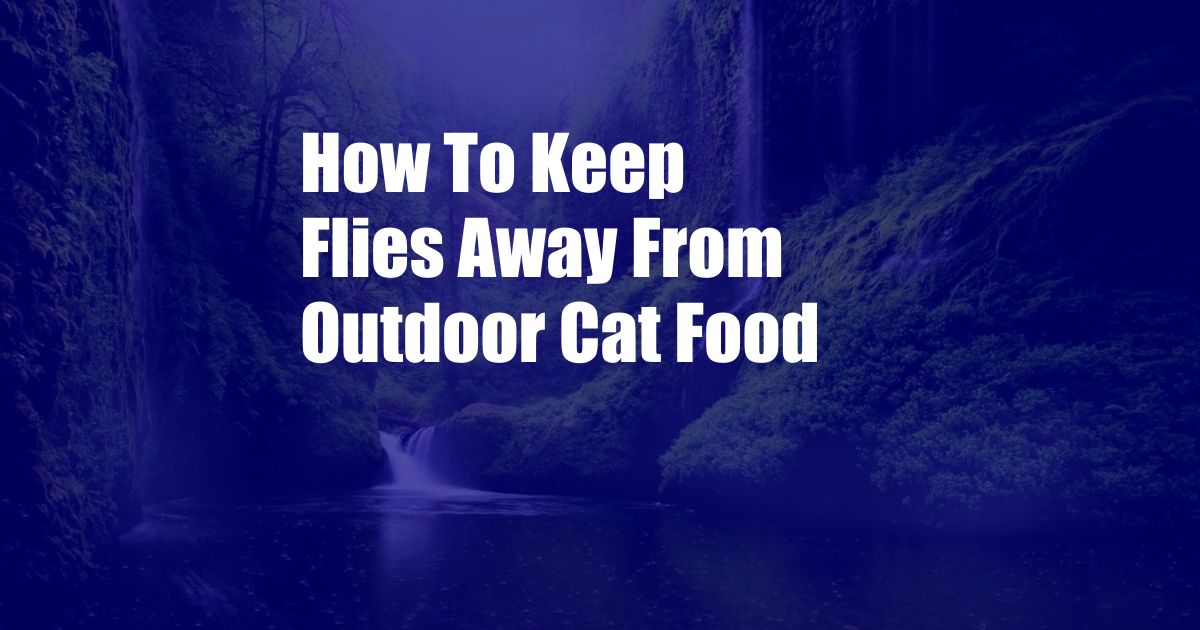
Keep Flies Away from Outdoor Cat Food: A Comprehensive Guide
As a devoted cat owner, I’ve faced the constant battle against persistent flies invading my feline’s outdoor food. These pesky insects not only create an unsanitary nuisance but can also pose health risks to my beloved pet. Determined to find a solution, I embarked on extensive research and experimentation to develop effective strategies for keeping flies at bay. In this comprehensive guide, I share my insights and expert advice to help you safeguard your cat’s food from these unwanted visitors.
Before delving into practical solutions, it’s essential to understand the behavior and preferences of flies. Houseflies, commonly found around cat food, are attracted to decaying organic matter and sweet substances, making pet food a prime target. By comprehending their habits, we can effectively implement strategies to minimize their presence.
Repellent Scents and Plants
Flies possess a keen sense of smell, and certain scents act as natural repellents. Eucalyptus, peppermint, and lavender are known for their insect-repellent properties. Consider planting these aromatic herbs around your cat’s feeding area or diffusing their essential oils indoors to create an invisible barrier against flies.
To enhance the effectiveness of scent deterrents, combine them with fly traps. Homemade traps can be crafted using a plastic bottle, vinegar, and a few drops of dish soap. The strong odor attracts flies, and the sugary solution traps them, creating a simple yet effective fly control method.
Food Storage and Hygiene
Proper food storage and hygiene practices play a crucial role in reducing fly infestations. Firstly, avoid leaving cat food outside for prolonged periods, especially during warm weather. Store food in airtight containers to prevent odors from attracting flies. Additionally, promptly dispose of any uneaten food to eliminate potential breeding grounds.
Maintaining cleanliness around the feeding area is equally important. Regularly wash food bowls with hot soapy water and disinfect the surrounding area to remove food residue and eliminate potential fly attractants. By adopting a regimen of proper storage and hygiene, you substantially reduce the likelihood of fly invasions.
Physical Barriers and Traps
Physical barriers can effectively prevent flies from reaching cat food. Cover food bowls with mesh or cheesecloth, creating a transparent barrier that allows air circulation while preventing flies from accessing the food.
For a more comprehensive approach, utilize commercial fly traps designed to attract and capture flies. These traps employ various methods, such as pheromones or UV light, to lure flies and trap them inside. Place the traps strategically near fly entry points or around the feeding area to maximize their effectiveness.
Expert Tips and Advice
In addition to the aforementioned strategies, consider incorporating the following tips to further enhance your fly prevention efforts:
- Avoid overfeeding: Excess food left outdoors attracts flies, so portion cat food appropriately.
- Choose strategic feeding locations: Select a feeding area that receives minimal direct sunlight and is protected from wind, reducing fly activity.
- Seal any potential entry points: Inspect your home for cracks or gaps that may allow flies to enter and seal them with caulk or weatherstripping.
- Consult a veterinarian: If you encounter persistent fly infestations despite implementing these measures, seek professional advice from your veterinarian. They may recommend additional strategies or address underlying health issues.
Frequently Asked Questions
Q: Are there any natural fly repellents that are safe for cats?
A: Yes, several essential oils, including peppermint, lavender, and eucalyptus, have insect-repellent properties and are generally safe for cats when used in moderation.
Q: Can I use pesticides to control flies near cat food?
A: It’s strongly advised against using pesticides near cat food as they can be toxic to both cats and flies. Consider non-toxic alternatives such as fly traps or natural fly repellents.
Conclusion
Keeping flies away from outdoor cat food involves a multi-faceted approach that combines scent deterrents, proper food storage and hygiene, physical barriers, and expert advice. By implementing the strategies outlined in this guide, you can effectively reduce fly infestations and ensure a clean and healthy environment for your feline companion.
Are you interested in learning more about effective pest control methods for cats? Visit our website for additional resources and guidance.